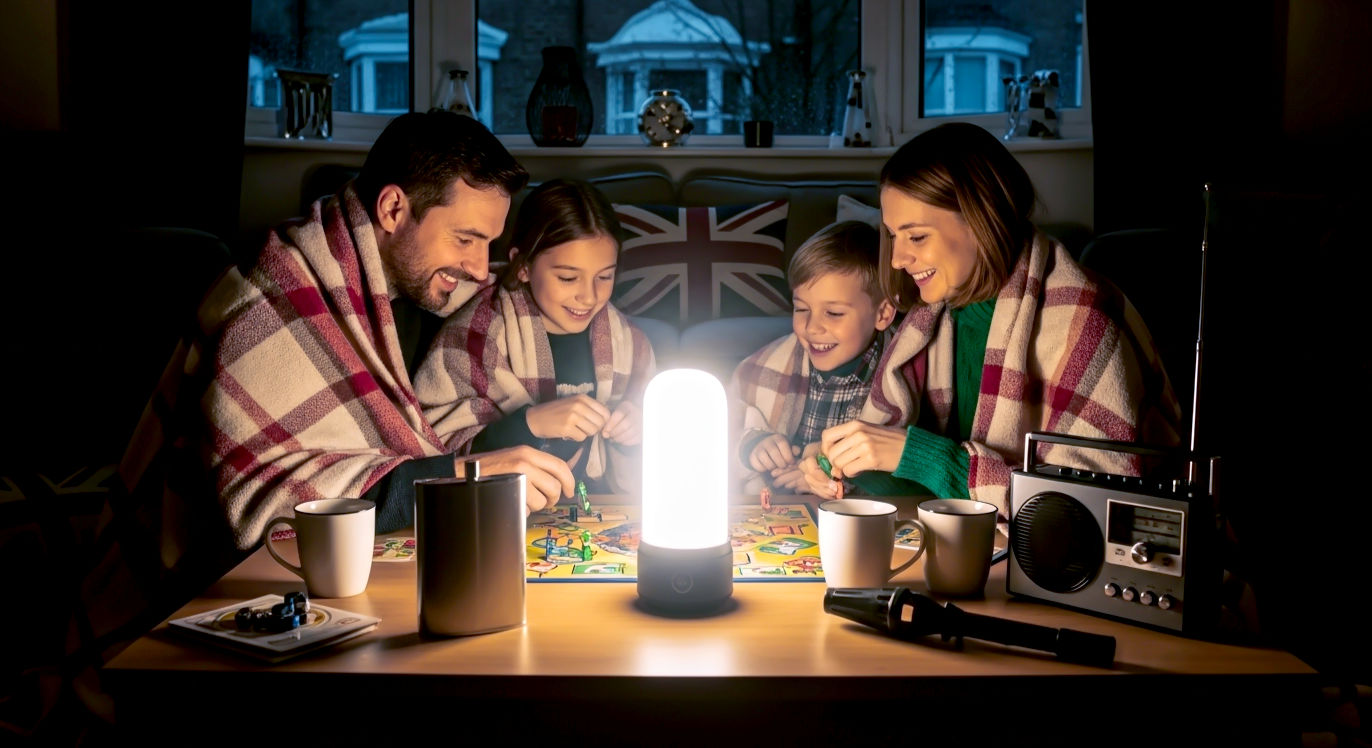The Great British Power Cut: Your Guide to Building a Home Survival Kit
Don’t get caught in the dark. This complete guide explains everything you need in a home survival kit for a UK power cut. Stay safe, warm, and connected.

This post may contain affiliate links. If you make a purchase through these links, we may earn a commission at no additional cost to you.
Picture this. It’s a dark, blustery Tuesday night in November. You’re settled on the sofa with a cuppa, ready for the big reveal on Bake Off. The rain is lashing against the windows, the wind is howling a bit dramatically, and then… click.
Silence. Darkness.
The telly goes dead. The hum of the fridge vanishes. The only sound is the storm outside and the sudden, unsettling quiet inside. It’s a power cut. For a moment, it’s a bit of a novelty. But then the questions start. Where are the torches? Are the kids okay? How am I going to charge my phone? And most importantly, how will I make another cup of tea?
Power cuts, or outages as they’re officially known, are a fact of life in the UK. While our National Grid is impressively reliable, our wild weather—from Storm Arwen to the Beast from the East—has a habit of reminding us who’s really in charge. Most power cuts are over in a few hours, but some can drag on for days, turning a minor inconvenience into a major headache.
This isn’t about doomsday prepping or hiding in a bunker. This is about good old-fashioned British common sense. It’s about spending a small amount of time and money now to build a simple home survival kit that will keep you and your family safe, warm, comfortable, and connected when the lights go out.
This is your definitive guide to getting prepared. We’ll cover everything from the absolute essentials to the clever extras that can make a blackout feel more like a cosy adventure than a crisis.
Why Bother? The Reality of Power Cuts in Britain
It’s easy to think a long power cut won’t happen to you. We flick a switch, and the lights come on. We take it for granted. But the system that delivers our power is a vast and complex network, and it’s not invincible.
Are Power Cuts Really That Common?
Statistically, the UK has one of the most reliable power networks in Europe. But that doesn’t mean it’s perfect. Thousands of smaller cuts happen every year, often fixed so quickly we barely notice. The real problems come during severe weather events.
Remember Storm Arwen in 2021? It left nearly a million homes without power, with some in rural parts of Scotland and northern England cut off for over a week in freezing conditions. It was a stark reminder that when nature throws a real tantrum, our modern comforts can disappear in an instant. Factors like falling trees, flooding at substations, and heavy snow can all cause significant damage that takes time to repair.
It’s So Much More Than Just No Lights
The immediate problem is darkness, but the knock-on effects are what make a prolonged power cut genuinely difficult, and even dangerous.
- No Heating: Most modern central heating systems, including gas boilers, need electricity to run their pumps and controls. In the depths of a British winter, a cold house can become a serious health risk, especially for the elderly, babies, and anyone with existing health conditions.
- No Hot Water: Your boiler won’t be able to heat water, meaning no warm showers or hot water for washing up.
- Communication Breakdown: Your Wi-Fi router will be dead, cutting off your internet access. Your phone will quickly become your only link to the outside world for news and updates, but its battery is finite.
- Cooking Problems: If you have an electric hob, oven, or microwave, you’ve got no way to cook a hot meal.
- Food Spoilage: The food in your fridge and freezer is on a countdown. Without power, a fridge will only stay cool for about four to six hours if you keep the door shut.
- Medical Equipment Failure: Anyone relying on mains-powered medical equipment, like a nebuliser or an electric hoist, is in a vulnerable position.
- Security Issues: Your home alarm system and electric gates won’t work, potentially compromising your security.
Putting a kit together is a small effort for a massive amount of peace of mind. It’s about taking control and ensuring you’re ready for the unexpected.
Building Your Core Survival Kit: The Absolute Must-Haves
Right, let’s get down to brass tacks. This is your starting line-up—the non-negotiable items that every single home should have tucked away. Think of it as your power cut foundation.
Lighting: Don’t Get Left in the Dark
The first thing you’ll reach for is a light source. Fumbling around in the dark for your phone (which you should be saving the battery on!) is a recipe for stubbed toes and frustration.
The Humble Torch: Your Best Friend in a Blackout
A torch is essential. Forget those old, clunky ones that gave off a pathetic yellow glow. Modern technology has made them brilliant.
- Simplified Explanation: You need a good torch. Maybe a few.
- Detailed Explanation: Go for LED torches. They are incredibly bright, last for ages, and their batteries don’t drain as quickly. It’s a great idea to have a small collection:
- A main, powerful torch: For lighting up a whole room or checking the fuse box from a distance.
- Smaller torches for each family member: Giving kids their own torch can make them feel safe and involved.
- A head torch: This is a game-changer. It leaves your hands free for cooking, finding things, or playing cards. Invaluable.
- A wind-up torch: A fantastic backup. A minute of winding can give you up to 30 minutes of light. No batteries needed, ever. Keep one in your kit, and you’ll never be completely without light.
Lanterns for All-Round Light
While a torch provides a focused beam, a lantern can light up an entire room, making it feel safer and more normal.
- Simplified Explanation: These are like portable, battery-powered lamps.
- Detailed Explanation: Again, LED lanterns are the way to go. They provide a soft, diffused light that’s perfect for the living room or kitchen. You can sit around it as a family, play a game, or read a book without everyone needing their own torch. Many are rechargeable via USB, so you can top them up with your power bank.
A Word on Candles: Use with Extreme Caution
There’s something romantic and old-fashioned about lighting candles, but in a power cut, they are a serious fire risk.
- Simplified Explanation: Candles are pretty but can easily start a fire. Be very careful.
- Detailed Explanation: A staggering number of house fires are caused by candles left unattended. They should only ever be a last resort. If you absolutely have to use them:
- Place them in sturdy, non-flammable holders on a flat, stable surface.
- Keep them well away from curtains, bedding, books, and anything else that could catch fire.
- Never put them under shelves or in enclosed spaces.
- Always keep them away from children and pets.
- Never, ever leave a lit candle unattended. Extinguish them all before you go to bed.
Communication: Staying in the Loop
When the power goes out, information is king. Knowing what’s happening and how long the outage might last can reduce anxiety and help you plan.
The Power Bank: Your Phone’s Lifeline
Your smartphone is your connection to the outside world, but its battery won’t last forever.
- Simplified Explanation: A portable charger to keep your phone going.
- Detailed Explanation: A fully charged power bank is one of the most important items in your kit. It means you can keep your phone on to check for updates from your power network operator, contact family, or just keep the kids entertained with a downloaded movie. Look for one with a high capacity, measured in milliampere-hours (mAh). A 10,000mAh power bank will charge a modern smartphone two to three times, while a 20,000mAh one will give you even more peace of mind. Remember to keep the power bank itself charged! Plug it in to charge whenever you do your six-monthly kit check.
The Old-School Wind-Up Radio
When the Wi-Fi is down and phone signal might be patchy, a radio is a reliable source of information.
- Simplified Explanation: A radio that works without batteries or mains power.
- Detailed Explanation: A wind-up AM/FM radio is a brilliant bit of kit. You can tune into local BBC radio stations for news, weather warnings, and updates on the power situation. Many models now come as multi-function devices, often including a built-in torch and a USB port that can provide a small emergency charge for your phone—enough for a quick call.
First Aid & Health: Safety First, Always
Accidents are more likely to happen in the dark. A simple trip or fall could result in a cut or sprain, so being able to deal with minor injuries is crucial.
A Proper First Aid Kit
This is a must-have for any home, power cut or not.
- Simplified Explanation: A box with plasters, bandages, and other medical bits.
- Detailed Explanation: You can buy excellent pre-made first aid kits from places like Boots, the St John Ambulance, or the British Red Cross. Or you can build your own. It should contain at least:
- Plasters in various sizes
- Sterile dressings and bandages
- Antiseptic wipes and cream
- Medical tape
- Scissors and tweezers
- Painkillers like paracetamol and ibuprofen
- Antihistamines for allergic reactions
- Disposable gloves Check the kit every six months, replace anything you’ve used, and check the expiry dates on medicines and creams.
Personal Medications and Needs
Don’t forget about your family’s specific health needs.
- Simplified Explanation: Pack any medicine you need to take regularly.
- Detailed Explanation: Ensure you have at least a one-week supply of any prescription medications. It’s also wise to have a written list of your medications, dosages, and your GP’s contact details. Don’t forget other essentials like spare glasses, contact lens solution, or hearing aid batteries.
Warmth & Comfort: Staying Cosy When It’s Cold
A cold house is miserable and can be dangerous. Keeping warm is a top priority, especially during a winter power cut.
Blankets, Duvets, and Layers
This is the simplest and most effective way to stay warm.
- Simplified Explanation: Wrap up warm in lots of blankets.
- Detailed Explanation: Gather all the blankets, duvets, sleeping bags, throws, and quilts you have. Pile them onto the sofas or beds. The key is to dress in layers. Multiple thin layers trap air and are more effective at insulating you than one single thick layer. A base layer of thermal underwear is a fantastic investment. Wool is a superb insulator, so dig out those woolly jumpers and blankets.
Hats, Gloves, and Thick Socks
You lose a surprising amount of body heat through your head, hands, and feet.
- Simplified Explanation: A woolly hat, gloves, and warm socks make a huge difference.
- Detailed Explanation: It might feel silly wearing a hat indoors, but it works. Keeping your extremities warm tells your body it doesn’t need to work so hard to conserve heat in its core, making you feel warmer all over. Slipper socks or a good pair of thick walking socks are essential.
Food & Water: Fuelling Your Wait
While you’re unlikely to face starvation in a short-term power cut, having access to food and water is important for comfort and morale.
Don’t Forget the Water
Your tap water should still work as it’s usually gravity-fed, but it’s always wise to have a backup.
- Simplified Explanation: Keep some bottled water just in case.
- Detailed Explanation: Store a few large bottles of mineral water—at least three litres per person per day. If you get a warning that a power cut is imminent (e.g., during a named storm), it’s also a great idea to fill a clean bathtub with water. You can use this for flushing toilets (using a bucket) and for washing.
No-Cook Food Supplies
You need food that doesn’t require an electric hob, oven, or microwave.
- Simplified Explanation: Pack snacks and tins that you don’t need to cook.
- Detailed Explanation: Aim for a three-day supply of non-perishable food for everyone in the house. Think high-energy and easy to eat. Good options include:
- Cereal bars, granola bars, and protein bars
- Biscuits (both sweet and savoury), crackers, and crispbreads
- Dried fruit, nuts, and seeds
- Tinned fruit, rice pudding, or custard (check they don’t need heating)
- Tinned fish or meat
- Crisps and other snacks And don’t forget the two most important items: a manual tin opener and food for your pets and babies.
Levelling Up Your Kit: The ‘Nice-to-Haves’
Once you’ve got the essentials sorted, you can add a few extras. These are the items that can turn a stressful ordeal into something far more manageable—and maybe even a little bit fun.
Cooking Without Power
A hot drink or a warm meal can boost spirits immensely, especially when it’s cold.
The Camping Stove: A Hot Meal and a Cuppa
A small, portable gas stove is an excellent addition to your kit.
- Simplified Explanation: A little stove like you’d use for camping is great for boiling water.
- Detailed Explanation: These stoves are cheap, easy to use, and perfect for heating a tin of soup or boiling a kettle for that all-important cup of tea. However, they come with a critical safety warning: never, ever use them indoors. They produce carbon monoxide (CO), a poisonous gas that has no smell or colour. It can kill you. Only use a camping stove in a well-ventilated area, like on a patio or in a garage with the main door wide open. Make sure you have a working carbon monoxide detector in your home.
The Good Old Barbecue
If you have a BBQ, it can be a lifesaver for cooking proper meals.
- Simplified Explanation: You can cook dinner on the barbecue.
- Detailed Explanation: Whether it’s gas or charcoal, your BBQ is a ready-made outdoor kitchen. You can cook sausages, heat up beans, or even boil water. Again, this is an outdoors-only solution due to the carbon monoxide risk. Make sure you have a good supply of fuel (a spare gas bottle or a bag of charcoal).
The Wonder of a Flask
A simple but brilliant tool.
- Simplified Explanation: A flask keeps drinks hot for hours.
- Detailed Explanation: If you get an advance warning of a power cut, or as soon as the power goes off, boil your kettle (if you have a gas hob) and fill a large flask with the hot water. It will stay hot for many hours, giving you an instant supply for tea, coffee, or a hot water bottle without needing to fire up the camping stove.
Entertainment: Beating the Blackout Boredom
Once you’ve established you’re safe and warm, boredom can quickly set in, especially if you have children.
- Simplified Explanation: Have things to do when the telly and internet are off.
- Detailed Explanation: A power cut is the perfect excuse to disconnect from screens and connect with each other. A well-stocked entertainment stash can be a godsend. Consider:
- Board games: Monopoly, Cluedo, Scrabble—dig out the classics.
- Playing cards: You can play dozens of different games with a single pack.
- Books and magazines: Make sure you have a good reading light, like a head torch.
- Puzzles: A big jigsaw puzzle can keep the family occupied for hours.
- For kids: Colouring books, crayons, Lego, and other non-electronic toys are perfect.
Practical Tools & Supplies
A few extra bits and bobs can be surprisingly useful.
- A Multi-Tool or Basic Toolkit: A Swiss Army knife or a Leatherman can handle countless small jobs. A basic toolkit with a screwdriver and pliers is also handy.
- Duct Tape: Because it can fix almost anything, at least temporarily.
- Important Documents & Cash: Keep copies of key documents (passports, driving licences, insurance policies) in a waterproof bag. It’s also wise to have a small amount of cash on hand. With no power, cash machines and card readers won’t work, so cash becomes king.
Sanitation & Hygiene
If a power cut lasts for more than a day, staying clean becomes important.
- Simplified Explanation: How to stay clean without hot water.
- Detailed Explanation: A pack of wet wipes can be used for a quick wash. Hand sanitiser is also useful for keeping germs at bay, especially before eating. Extra bin bags are always handy for rubbish.
Putting It All Together: Storing and Maintaining Your Kit
You’ve gathered all your supplies. Now what? Proper storage and regular checks are vital to making sure your kit is ready to go when you need it.
Where to Keep Your Kit
Don’t just scatter your items around the house. Keep everything in one place.
- Simplified Explanation: Put it all in a box somewhere easy to find.
- Detailed Explanation: The best solution is one or two sturdy, stackable plastic storage boxes with lids. They’re waterproof and will protect your supplies. Alternatively, a large backpack or a holdall works well. Store your kit somewhere cool, dry, and easily accessible—not buried at the back of a cluttered loft. Good spots include:
- The cupboard under the stairs
- A utility room or pantry
- An accessible shelf in the garage Make sure everyone in the household knows where it is. In an emergency, you don’t want to be hunting for it in the dark.
The Six-Month Check-Up
Your kit isn’t a ‘set and forget’ project. It needs a little bit of TLC twice a year.
- Simplified Explanation: Check your kit twice a year to make sure everything still works.
- Detailed Explanation: A great way to remember is to do it when the clocks change in spring and autumn. Set a reminder on your phone or calendar. Here’s your checklist:
- Check Batteries: Test your torches and radio. Check the expiry dates on any spare batteries and replace them if needed.
- Check Food and Water: Look at the ‘use by’ dates on all your food and water. Anything that’s nearing its date, use it up and replace it. This is a great way to rotate your stock so nothing goes to waste.
- Check First Aid Kit: Replace any used items and check the expiry dates on medicines and creams.
- Charge Your Power Bank: Plug in your power bank and give it a full charge.
- Review Your Needs: Has your family’s situation changed? Do you have a new baby? Has someone started taking new medication? Update the kit accordingly.
During the Power Cut: A Step-by-Step Action Plan
The lights have gone out. Don’t panic. Take a deep breath and follow these simple steps.
Step 1: Check if It’s Just You
Look out of your window. Are the streetlights on? Can you see lights on in your neighbours’ houses? If so, it might just be your property. Go and check your trip switch on your fuse box. If that doesn’t solve it, you may have an internal electrical fault and need to call an electrician.
Step 2: Report the Outage and Get Information
If your neighbours are also in the dark, it’s a wider network problem. The first thing to do is find out who to contact.
- Call 105: This is the free, nationwide number to call to report a power cut and get information. It will put you through to your local electricity network operator. This is not your energy supplier (the company you pay your bills to), but the company that manages the cables and infrastructure in your region.
- Go Online: Use your charged smartphone to visit your network operator’s website or check their social media channels (Twitter/X is often very good for live updates). You can find your operator by putting your postcode into the Energy Networks Association website.
Step 3: Unplug and Protect Your Electronics
When the power is restored, it can sometimes come back with a surge, which can damage sensitive electronics.
- Turn off and unplug items like your TV, computer, games console, and smart speakers. It’s a good idea to leave one light switched on so you have an obvious signal when the power returns.
Step 4: Check on Your Neighbours
Once you’ve got yourself sorted, take a moment to think about others.
- Check on elderly or vulnerable neighbours. Pop round to see if they’re okay and if they need anything. A quick chat and a shared flask of hot water can make a world of difference. This is what community is all about.
Step 5: Food Safety – The Fridge and Freezer Rule
To stop your food from spoiling, you need to preserve the cold air inside your fridge and freezer.
- Keep the doors shut. Don’t be tempted to keep opening them to check. A fridge will keep food safe for about 4-6 hours. A half-full freezer will last about 24 hours, while a full freezer can last up to 48 hours.
Conclusion: Prepared, Not Scared
Creating a home survival kit for a power cut isn’t about being paranoid. It’s one of the most practical and sensible things you can do to look after your family. For the cost of a few takeaways and an hour of your time, you can build a comprehensive kit that turns a potential crisis into a manageable inconvenience.
With a good torch, a charged power bank, warm blankets, and a few snacks, you can ride out a power cut in relative comfort. It might even be a welcome chance to switch off from the digital world and enjoy a family board game by lantern light.
So, this weekend, why not get started? Gather your supplies, pack your box, and rest easy knowing you’re prepared for the next time the lights go out just as you’re about to put the kettle on.
Further Reading & Resources
For more information and real-time updates during an emergency, these resources are invaluable:
- Met Office: For the latest weather warnings in your area.
- Energy Networks Association: To find your local network operator.
- National Grid ESO: For live information about Great Britain’s electricity system.
- St John Ambulance: For first aid advice and to buy kits.
- Ready Scotland & gov.Wales: For country-specific emergency preparedness advice.






